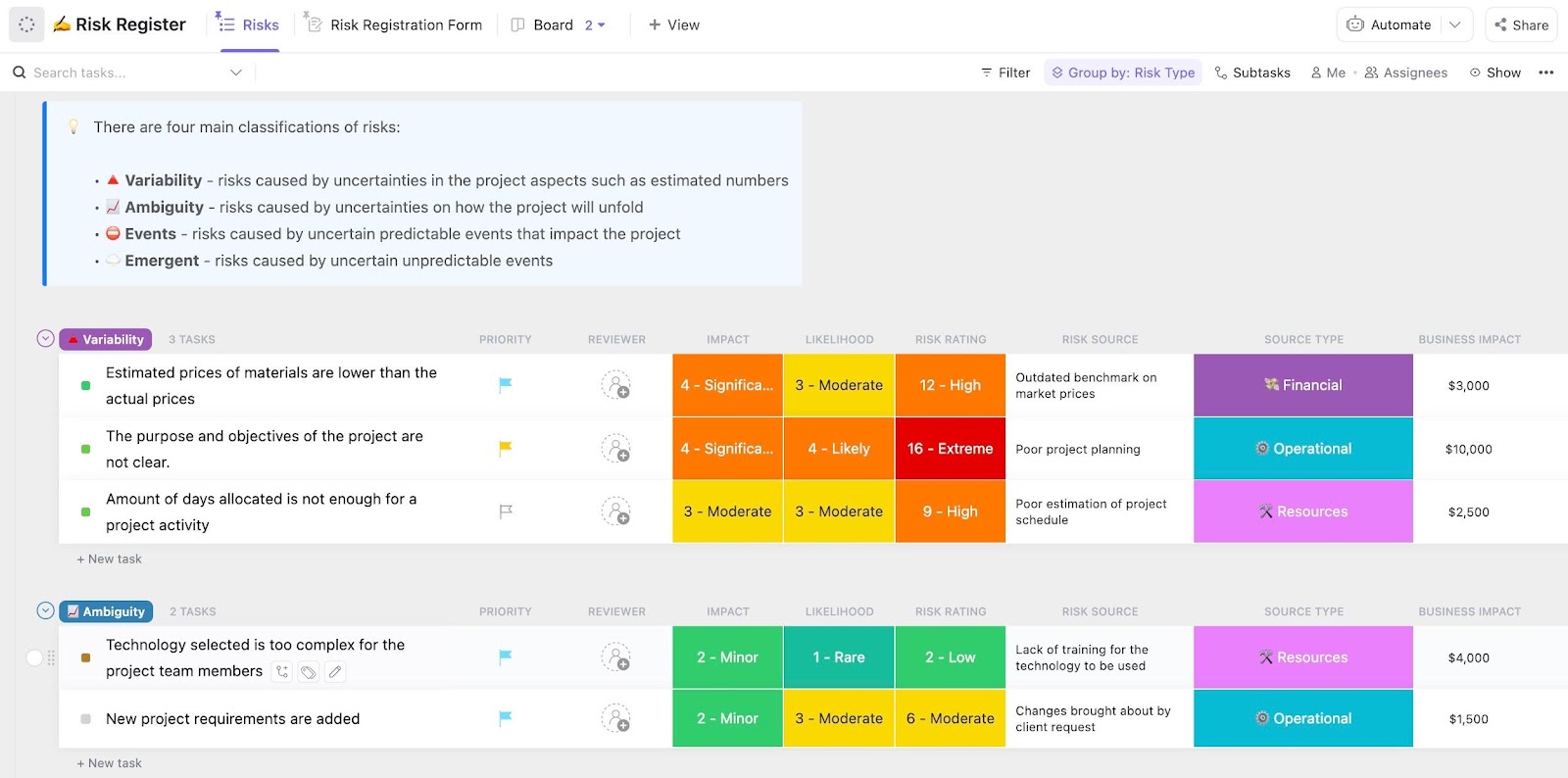Whether it’s life, business, a project, or a task, risk is an inevitable part.
These unexpected challenges could include economic downturns, market variations, cybersecurity threats, or supply chain disruptions to derail progress and pose costly setbacks. For this reason, a risk management plan could be the fine line between success and failure.
🧠 Fun Fact: Research indicated that 41% of organizations have witnessed three or more critical risk events in a calendar year!
But what does a risk management plan look like? What are its core components?
This guide answers your burning questions—from the basics to real-world scenarios. So, let’s dive in!
⏰ 60-Second Summary
- A risk management plan is a structured approach to identifying and mitigating risks
- The key components of a risk management plan include:
- Risk register
- Risk breakdown structure
- Risk assessment matrix
- Risk management methodology
- Risk response plan
- Risk communication plan
- Risk budget and documentation
- Some common types of risk management plans cover business, project, IT, and financial risk management plans
- Preparing a risk management plan is a 7-step process involving risk identification, assessment, response planning, ownership assignment, trigger documentation, backup planning, and setting risk thresholds
- As the everything app for work, streamlines the process end to end, from risk identification to mitigation
Risk Management Plan: Examples and Types for Project Managers and Leaders
What Is a Risk Management Plan?
A risk management plan is a structured approach to monitoring, identifying, analyzing, and responding to potential risks affecting a business or project. It is a proactive risk mitigation strategy that minimizes uncertainty, addresses challenges, safeguards resources, and smooths operations.
When implemented correctly, a proper risk management plan enhances decision-making, improves operational resilience, and maintains stakeholder confidence even in unexpected circumstances.
💡Pro Tip: What helps the most when managing a catastrophic event? A clean dashboard that displays all the risk management metrics in a structured manner. Learn how to build one! 👇🏼
Key Components of an Effective Risk Management Plan
A risk management program is highly structured and contains several elements. Some of the key components include:
1. Risk register
The risk register is a centralized document that records all identified project risks. You’ll typically create this during the planning phase.
Once you have a list of potential risks, you’ll map their impact, likelihood of occurrence, and risk mitigation strategies against them. The risk register is a reference for key stakeholders to track risks across the project lifecycle.
2. Risk breakdown structure (RBS)
The RBS is a hierarchical framework that classifies risks based on their sources. These sources could be technical, operational, financial, or external factors.
Such a structured layout makes it easier for team members and key stakeholders to analyze and prioritize risks systematically and to allocate resources during risk mitigation efforts.
3. Risk assessment matrix
The risk assessment matrix is a visual illustration of the risk register. In this matrix, you assign priorities to each risk, which helps identify high-impact risks.
The risk assessment matrix also powers informed decision-making by ensuring the risk management plan focuses on the most critical threats to minimize disruptions.
📮 Insight: 92% of knowledge workers risk losing important decisions scattered across chat, email, and spreadsheets. Critical business insights get lost in the digital noise without a unified system for capturing and tracking decisions.
With ’s Task Management capabilities, you never have to worry about this. Create tasks from chat, task comments, docs, and emails with a single click!
4. Risk management methodology
This component of the risk management plan outlines the organization’s approach to identifying, analyzing, mitigating, and monitoring risks.
It contains frameworks like qualitative and quantitative risk analysis, risk control techniques, and risk monitoring mechanisms. This step is crucial to an effective risk management plan.
5. Roles and responsibilities
This section clearly defines the roles and responsibilities within the risk management plan and identifies the stakeholders responsible for risk identification, assessment, mitigation, and communication.
Clear allocation of roles and responsibilities maintains accountability and prepares the stage for effective risk handling when needed.
6. Risk response plan
A risk response plan outlines the actions needed to address identified risks. It primarily contains avoidance, mitigation, transfer, and acceptance strategies.
Fundamentally, the response plan minimizes the impact of risks and improves preparedness. Overall, it is crucial for reducing project delays or failure.
7. Risk communication plan
The risk communication plan details how the key stakeholders will share all the risk-related information. Timely updates during a crisis can help maintain transparency and lend a flavor of proactiveness to risk mitigation plans.
This Communication Plan Template by comes with pre-defined reporting structures, communication channels, and the frequency of risk discussions. Having a structured communication plan prevents misunderstandings while sharing critical updates as teams work together to manage risk effectively.
8. Risk management budget
Some project risks may carry a financial element. In this case, project managers may allocate a budget to cover any costs related to the risk. This includes the expenditure for risk analysis tools, contingency planning, and crisis response measures.
9. Documentation and reporting
The documentation and reporting section of the risk management plan lays the foundation for continuous improvement. Use it to analyze risk occurrences, response effectiveness, and outcomes. This is a reference to help you fine-tune your risk strategies for future projects and comply with prevailing industry standards.
🔎 Did You Know?
The top five risks to global businesses include:
- Cyber incidents (38%)
- Business interruption (31%)
- Natural catastrophe (29%)
- Regulatory changes (25%)
- Climate change (19%)
Types of Risk Management Plans With Examples
Your risk management needs depend on the industry, organization, or project.
However, there are broad categories of risk management plans that you could customize depending on your specific and unique requirements. Let’s check out these different types of risk management plans:
1. Business risk management plan
A business risk management plan identifies and mitigates risks that could impact operations, reputation, or financial stability. These include regulatory compliance issues, market fluctuations, supply chain disruptions, and reputational damage.
A strong business risk management plan anchors the company against external and internal uncertainties.
📌 Real-world Example:
British banks like Barclays, Lloyds, and NatWest faced potential financial instability due to fluctuations in interest rates. To combat this, they implemented interest rate swaps to hedge against declining rates. This “caterpillar” strategy will generate more than £50 billion over three years. Structural hedging is a key component of banks’ business risk management plans.
2. Project Risk Management Plan
A project risk management plan identifies, assesses, and mitigates risks that hinder project success. These risks include scope creep, resource constraints, scheduling delays, and cost overruns. A compelling plan accounts for all project risks from planning to execution.
📌 Real-world Example:
The Gordie Howe International Bridge involves building a six-lane bridge at the US-Canada border crossing. It is North America’s largest infrastructure project, with a comprehensive project risk management plan given its complexity. This includes regular risk assessment, contingency planning, and ongoing monitoring to ensure the project’s success.
3. IT risk management plan
The IT risk management plan minimizes technology, cybersecurity, and data protection risks. This safeguards systems from cyber threats, malicious actors, software failures, compliance breaches, and other project risks.
📌 Real-world Example:
Capital One recognized the need to modernize its IT infrastructure to meet customer demands and operational efficiency. The company implemented an IT risk management plan while migrating its operations to the cloud. Proactive risk mitigation strategies helped the company bolster its cybersecurity measures and improve system resilience during digital transformation.
4. Financial risk management plan
As the name indicates, the financial risk management plan minimizes risks related to market volatility, interest rates, credit exposure, and liquidity issues. It encompasses strategies to manage economic upheavals, investment losses, and unexpected financial disruptions.
📌 Real-world Example:
Norway’s Government Pension Fund Global recognized the financial risks associated with environmental degradation and the depletion of natural resources. As a result, its financial risk management plan accounts for ecological risks to safeguard investments against the economic impacts of natural depletion and climate change.
5. Compliance risk management plan
A compliance risk management plan maintains legal and regulatory compliance with the prevailing norms. Failure to adhere to these requirements could lead to penalties, legal disputes, and reputational damage. This plan helps identify regulatory risks, monitor compliance, and effect corrective actions.
📌 Real-world Example:
In the aftermath of the 2016 fake-account scandal, Wells Fargo faced significant compliance issues. To overcome these, the company enhanced its compliance risk management plan by hiring external experts for compliance roles and following structured plans to address regulatory concerns. It has closed five regulatory actions, exemplifying its commitment to the established compliance risk management plan.
6. Operational risk management plan
An operational risk management plan enables businesses to mitigate risks associated with daily processes, such as supply chain disruptions, equipment failures, and workforce shortages.
Overall, such a plan maintains smooth business operations despite operational challenges.
📌 Real-world Example:
A fire at Heathrow Airport’s North Hyde substation caused a power outage and disrupted operations. The operational risk management plan involved reconfiguring the network, deploying backup power systems, coordinating with airlines, and communicating the latest status to the stakeholders for increased transparency. Such a proactive risk management plan helped restore operations faster.
How to Create a Risk Management Plan
Creating a risk management plan involves effectively identifying, assessing, and mitigating risks. Let’s take the example of a software development company looking to launch a new product to understand the process.
Perform risk identification
The first step is risk identification. You must account for all potential risks that may impact the project. Brainstorm with your project team, analyze past projects, and review industry-specific threats to identify all possible project risks.
For instance, risks in a software development project could include scope creep, software bugs, and cybersecurity vulnerabilities. Documenting such project risks in the early stages can better prepare you to address them.
Carry out risk assessments
Once you have your list of identified risks, assess their likelihood and potential impact. Depending on their probability and severity, you may use a risk assessment checklist or a matrix to classify the risks as low, medium, or high.
A cybersecurity incident in a software development scenario could have a high impact but low likelihood. However, testing delays could have a high impact and high probability. Perform risk assessments in this manner to prioritize risks and address the most critical ones first.
’s Risk Assessment Whiteboard Template helps your project team visually map out potential risks and classify them by severity. They can then create and assign effective response plans to neutralize the risk if it occurs.
Why you’ll love this template:
- Enable collaboration between teams to develop risk-reduction strategies
- Implement Custom Statuses like Open and Complete to track risk assessment progress
- Optimize risk assessment tracking with tagging, nested subtasks, multiple assignees, and priority labels
Prepare a risk response plan
The risk response plan guides the project team in strategies to mitigate, transfer, accept, or avoid risks. The actions vary for each identified risk, but the objective is the same: to reduce its impact. A response plan prevents reactive decision-making and prepares you to address the calamity better.
Using cybersecurity as an example, the immediate response would be to quarantine the data sets and quickly address the breach. In the long run, one should strengthen encryption and conduct frequent security audits.
When encountering a risk, you can:
Accept: Acknowledge the risk and prepare contingency plans in case it materializes ✅
Avoid: Eliminate the risk by introducing adjustments to the processes or plan 🛠️
Mitigate: Minimize the likelihood or impact of the risk through preventive measures 🎯
Transfer: Shift the responsibility of the risk to a third party 🔁
Assign risk owners
A risk owner is responsible for monitoring and managing the risk assigned to them. This mechanism ensures accountability and prompt action in a risky event.
The IT security team would be the risk owner for all cybersecurity risks, and the project manager would oversee any scope-related risks. This clear and demarcated ownership prevents confusion and triggers prompt mitigation efforts.
Document risk triggers
Risk triggers are early warning signs indicative of a risky event. Identifying these triggers beforehand allows the project team to act before the problem escalates.
For instance, frequent changes in client requirements can trigger scope creep. The project manager may implement a change control process to monitor this and prevent scope-related risks.
Create a backup plan
A backup or a contingency plan offers alternative strategies for when a risk avalanches into a crisis. This may entail deploying additional resources, securing emergency funding, or re-engineering project timelines.
Again, if a key developer leaves the team midway through software development, the backup plan may involve cross-training employees, hiring a contractor, or outsourcing the task to prevent delays.
Identify risk tolerance and threshold
Every project has a risk tolerance and a risk threshold. The threshold primarily defines how much risk an organization is willing to tolerate. Establishing a clear risk threshold supports decision-making. It helps project managers gauge when to continue, pivot, or escalate an issue. The threshold also affects a project’s viability, preventing excessive losses and other risks.
For instance, if the delay in software testing exceeds a certain number of days, senior management may outsource the process or bring in more testers to speed it up.
How can AI help with risk management?
- To maximize efficiency, AI tools can automate data gathering, task assignments, and report creation within risk management workflows
- For enhanced risk understanding, AI provides analytical insights, identifying patterns and predicting potential risks through data analysis and NLP
- To foster seamless collaboration, an integrated AI tool can help summarize discussions and automate notifications, ensuring clear and timely communication among stakeholders
Looking for an AI tool that does all of this and more? Brain, ’s built-in AI assistant, can help.


Many organizations use specialized tools and templates to streamline risk management. Here’s an overview of the different options available:
Risk register software (Best for centralized risk tracking)
Risk register software helps businesses maintain a structured database of potential risks and their status, impact, and assigned mitigation actions. This framework offers a centralized view of all identified risks, allowing teams to track and update real-time risk information.
In addition, advanced risk register tools include automation, customizable workflows, and integration with project management tools.
Enterprise risk management (ERM) software (Best for strategic risk oversight)
Enterprise risk management software targets organizations seeking a holistic approach to risk management across departments. It offers enterprise-wide risk analysis, aligns with strategic goals, and ensures compliance with industry regulations.
ERM tools typically contain reporting dashboards, predictive analytics, and workflow automation for effective risk governance.
Governance, risk, and compliance (GRC) tool (Best for regulatory and policy compliance)
As the name indicates, GRC software integrates governance, risk, and compliance processes into a single workflow. This is crucial for organizations in specific industries that want to meet regulatory requirements while effectively managing potential risks.
Moreover, GRC tools are packed with features like audit tracking, policy management, and automated compliance reporting, which add compliance to the risk management and governance framework.
(Best for comprehensive risk management)
is the everything app that offers comprehensive tools to improve risk management by making it more structured and proactive.
With ’s help, teams efficiently identify, assess, and mitigate risks by leveraging its customizable features, such as Dashboards, Custom Fields, Automations, and Tasks. With real-time collaboration and visibility, project teams stay ahead of potential risks and ensure project success.
For risk tracking, allows users to create a Risk Register using Custom Fields to categorize risks by severity, probability, and impact. Teams can assign risk-specific priorities and use Task Statuses to track risk mitigation progress.
If creating one from scratch feels like too much work, you have the Risk Register Template to get you started. Use it to identify risks, their impact, and mitigation strategies, and stay systematic and organized without any hassle.
You also have Whiteboards to provide a centralized view of all project risks, making monitoring trends and taking preventive actions easy. Convert the data into a risk assessment matrix, visualize possible risks, and categorize them into color-coded sections to ensure that nothing slips through the cracks.


In addition, the Gantt Chart and Timeline Views provide visual representations of tasks and potential delays, helping teams address risks before they affect project deadlines.
Here’s what Raúl Becerra, Product Manager at Atrato, had to say about using for monitoring risks:


Tasks lets you assign risks as tasks, making it easier to observe them. Each task is traceable, and you can assign priorities, designate risk owners, and automate response plans.
further helps mitigate risks by automating workflows, setting dependencies, and assigning accountability. Automations trigger alerts or reassign tasks when risk levels change, ensuring proactive management.


For documentation, Docs allows teams to store risk assessments, contingency plans, and past risk logs in a centralized, easily accessible format. Real-time collaboration features make it easy for teams to discuss and update risk-related information dynamically.
Additionally, integrations with cloud storage tools ensure that all critical documents are connected within the platform for assessing risks.
Stay Risk-Free with
A structured risk management plan helps organizations anticipate, assess, and respond to uncertainties that could otherwise disrupt operations. Whether you’re managing business, project, IT, or financial risks, a clear risk management strategy fuels informed decision-making and long-term stability.
Managing risks without the appropriate tools and templates can quickly become overwhelming. This is where provides a comprehensive solution for all your risk management needs and is equipped with features to facilitate risk tracking, assessment, and response.
Sign up for today and take control of your risk management process! 🏆


Everything you need to stay organized and get work done.







%20Abstract%20Background%20112024%20SOURCE%20Amazon.jpg)








